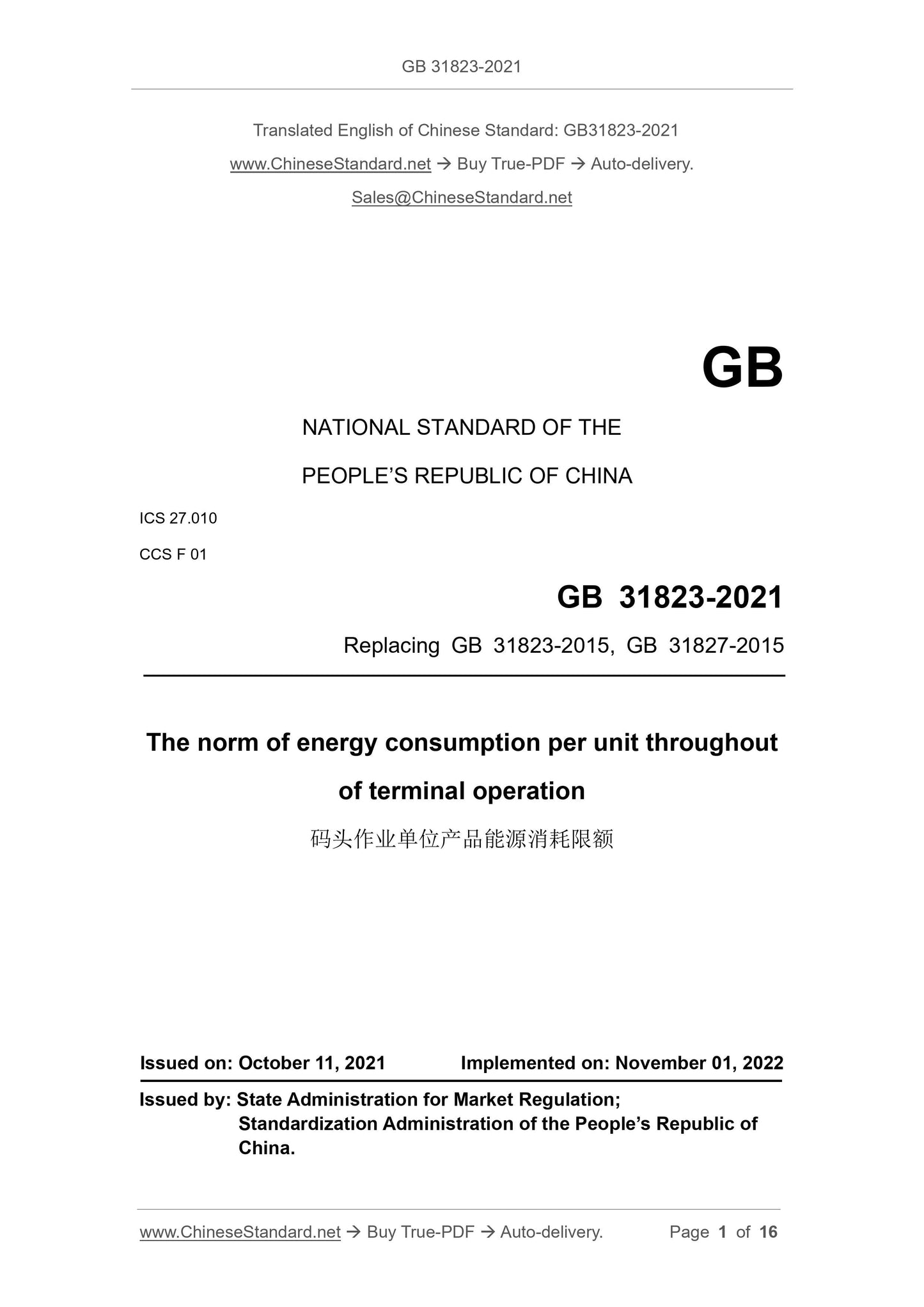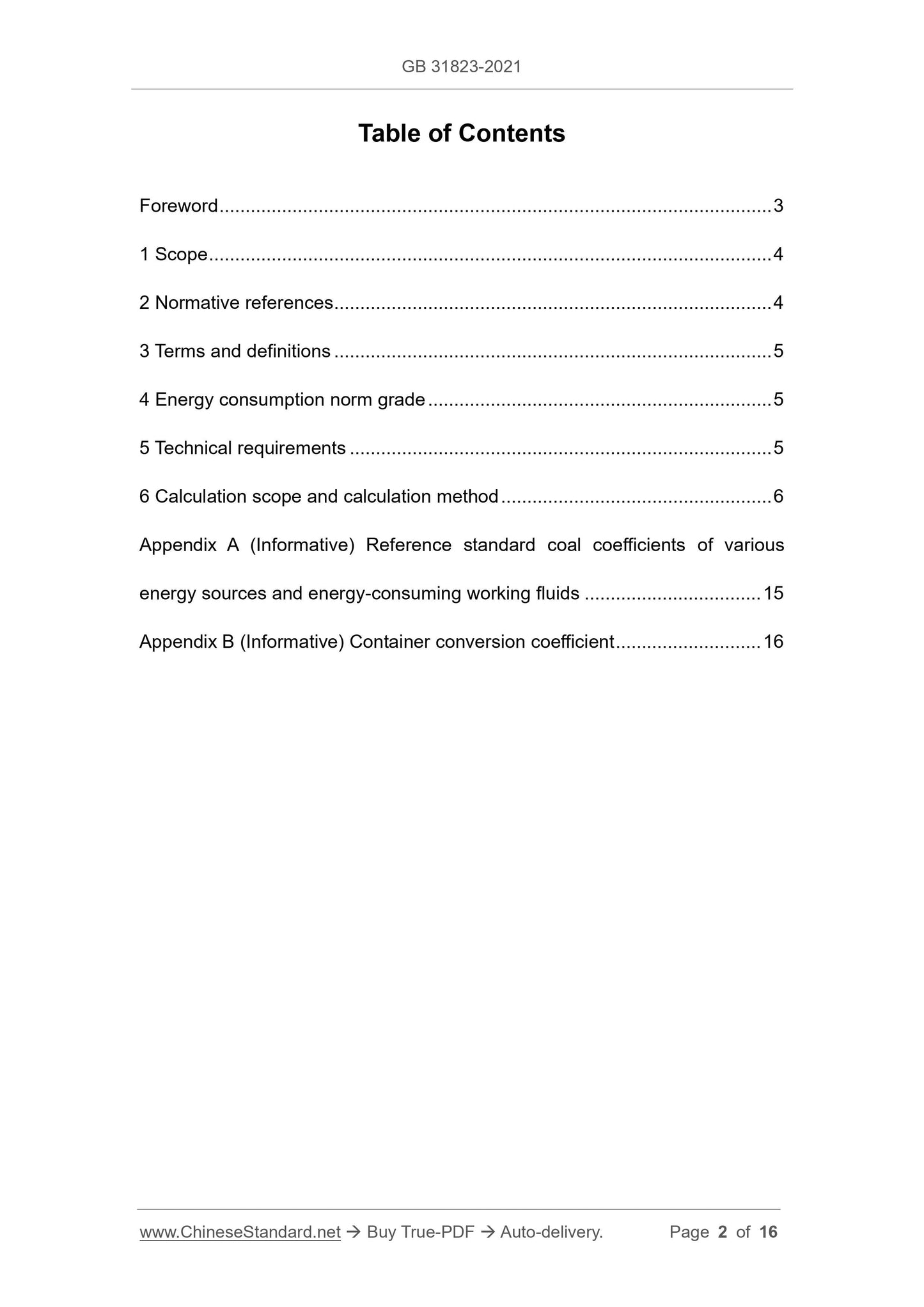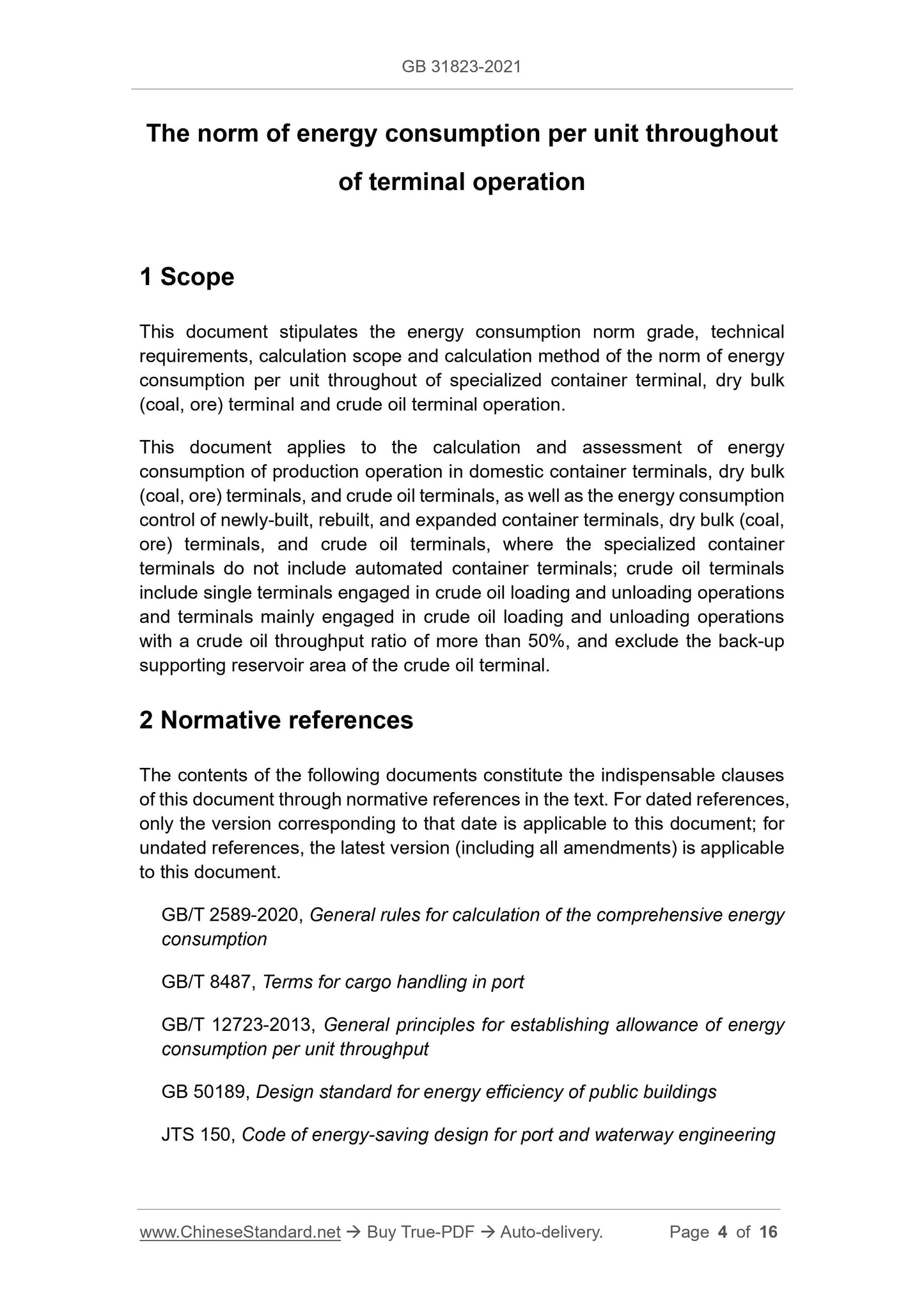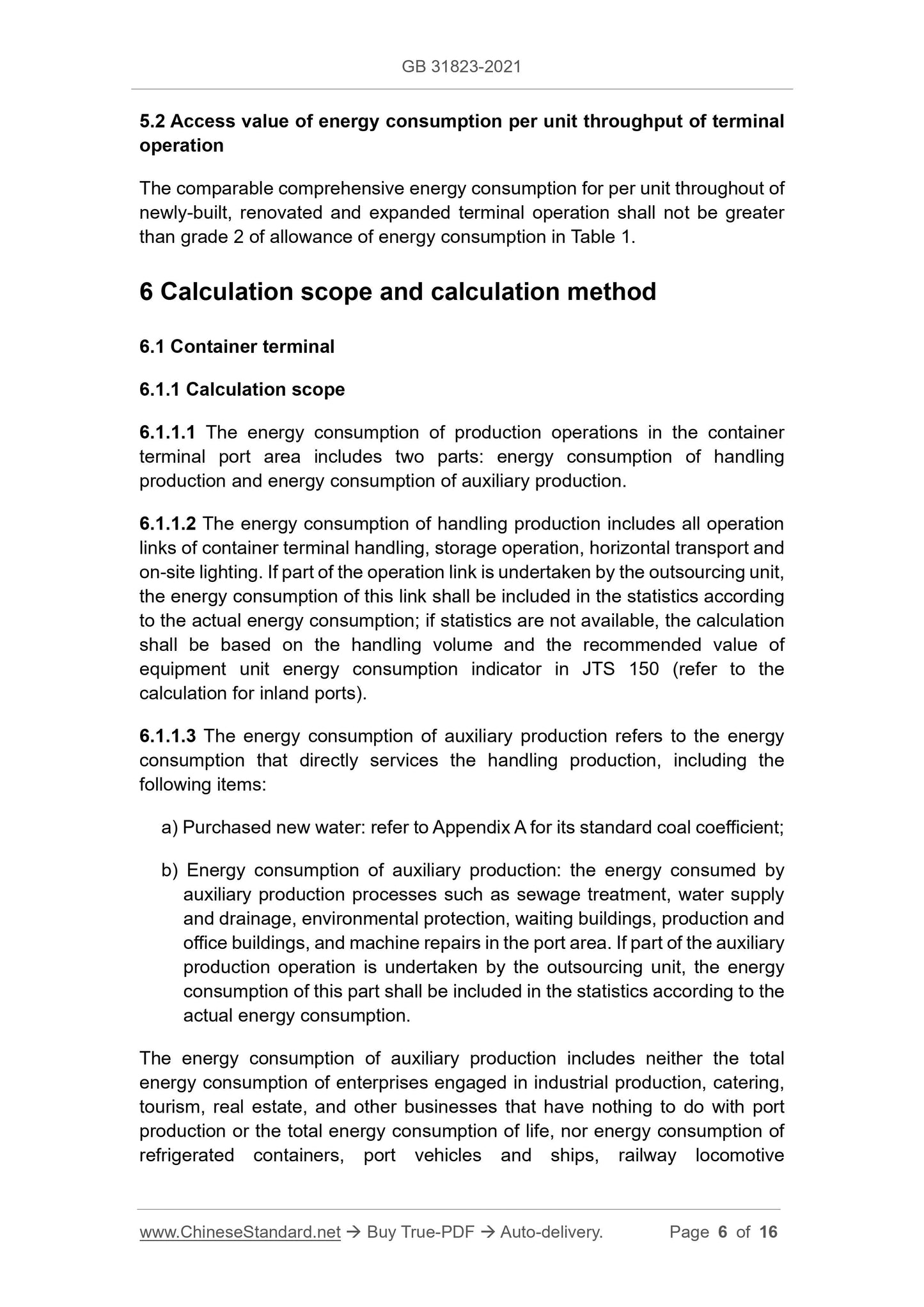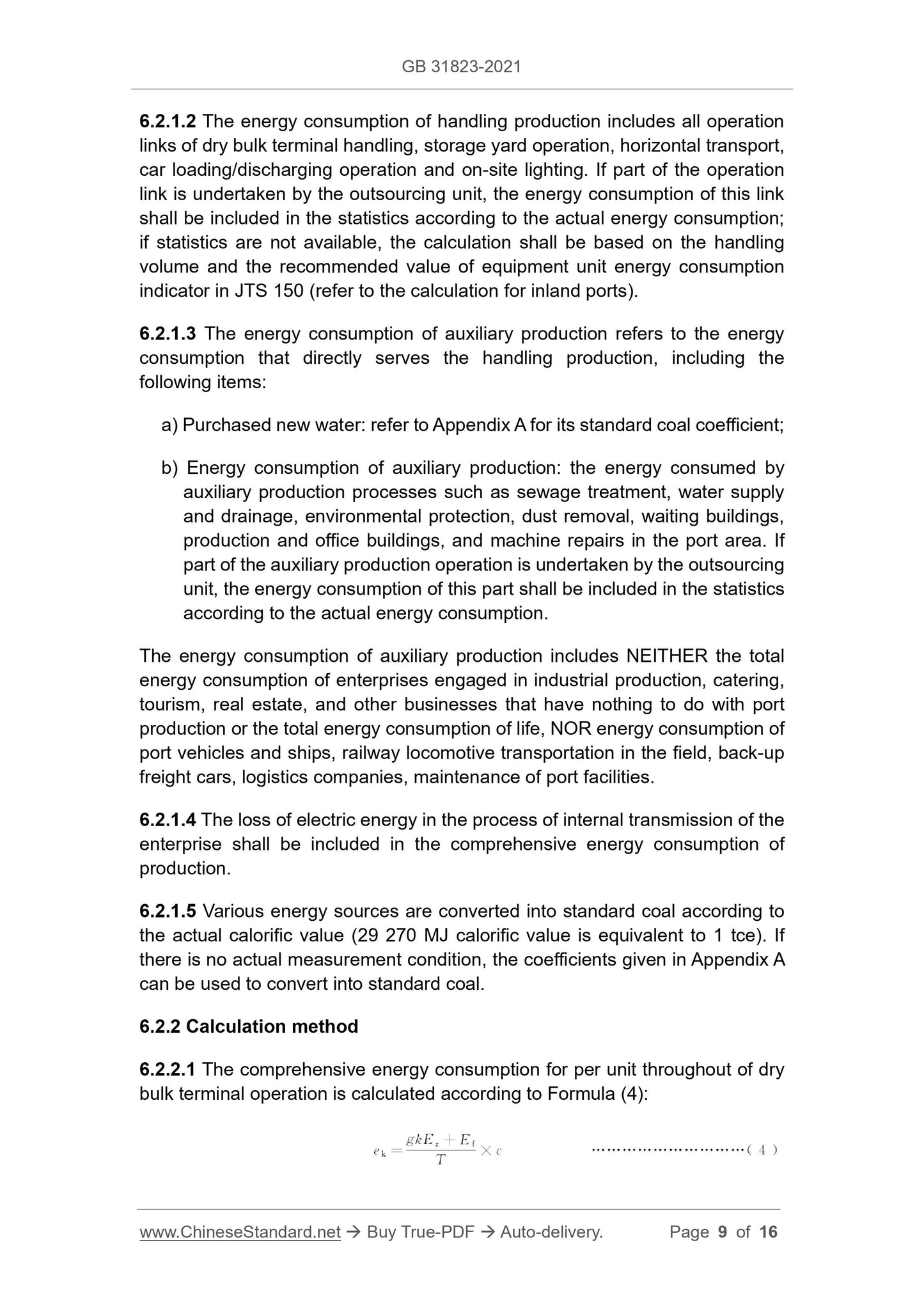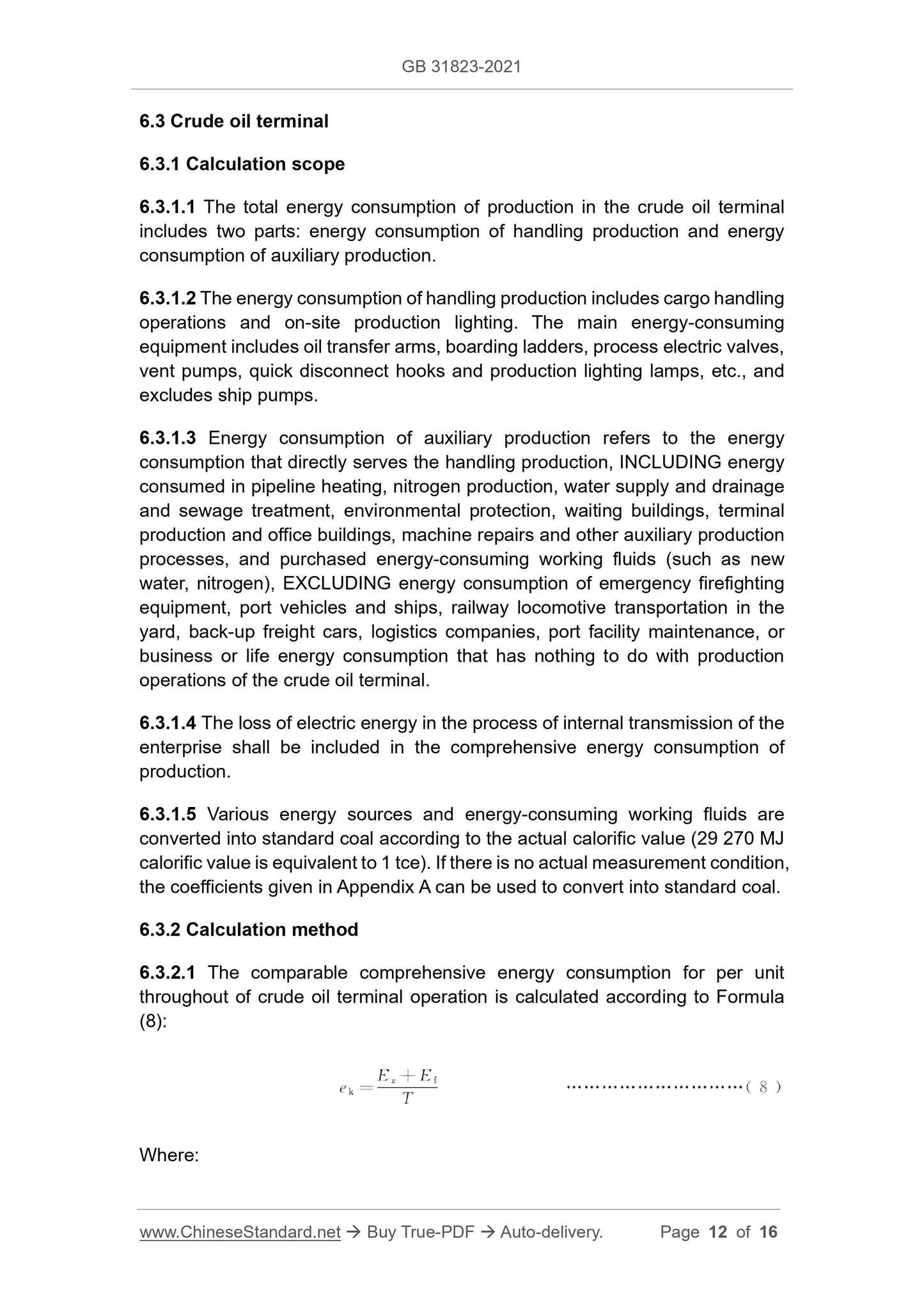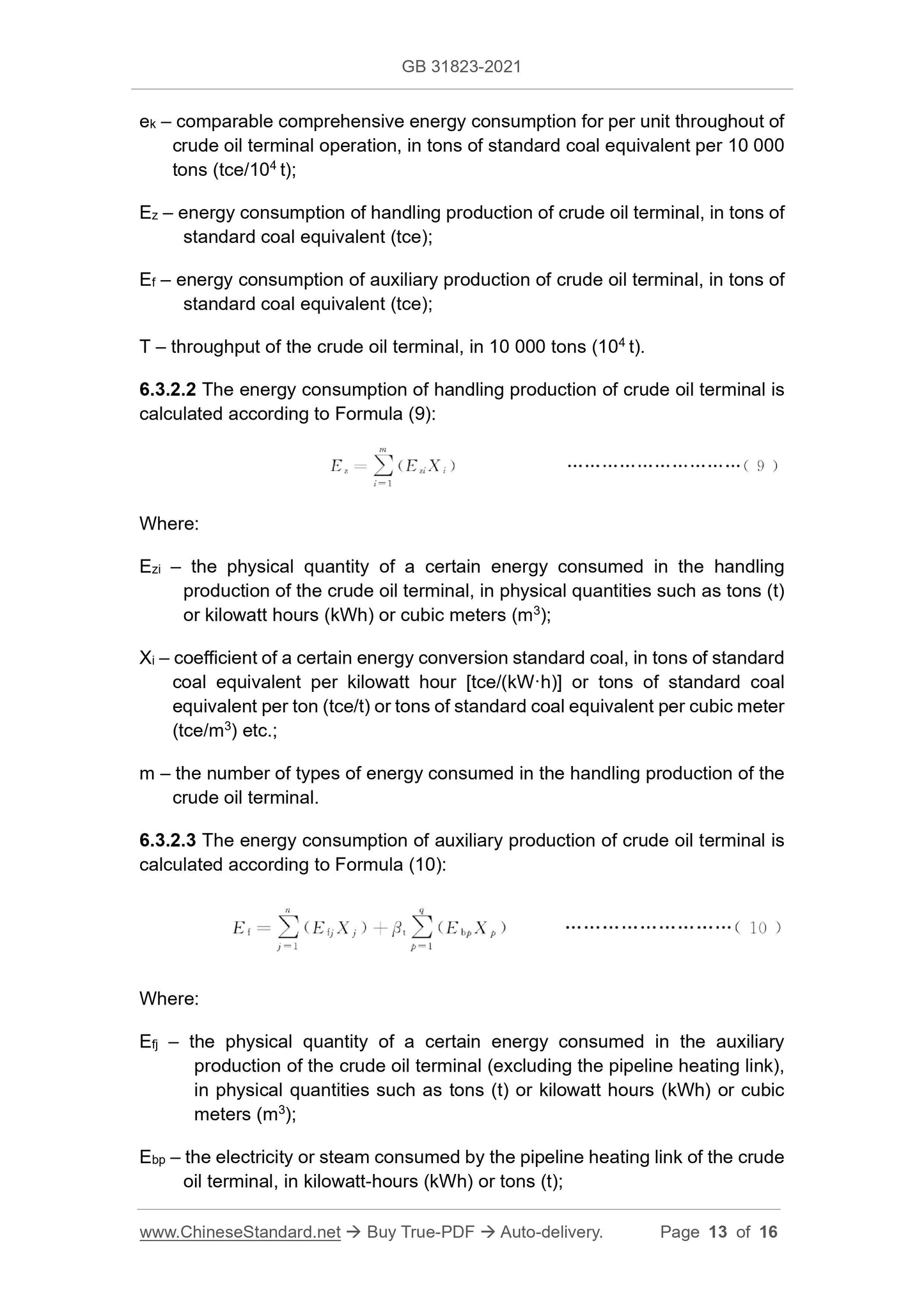1
/
of
7
PayPal, credit cards. Download editable-PDF & invoice In 1 second!
GB 31823-2021 English PDF (GB31823-2021)
GB 31823-2021 English PDF (GB31823-2021)
Regular price
$200.00 USD
Regular price
Sale price
$200.00 USD
Unit price
/
per
Shipping calculated at checkout.
Couldn't load pickup availability
Delivery: 3 seconds. Download true-PDF + Invoice.
Get QUOTATION in 1-minute: Click GB 31823-2021
Historical versions: GB 31823-2021
Preview True-PDF (Reload/Scroll if blank)
GB 31823-2021: The norm of energy consumption per unit throughout of terminal operation
GB 31823-2021
GB
NATIONAL STANDARD OF THE
PEOPLE’S REPUBLIC OF CHINA
ICS 27.010
CCS F 01
Replacing GB 31823-2015, GB 31827-2015
The norm of energy consumption per unit throughout
of terminal operation
ISSUED ON: OCTOBER 11, 2021
IMPLEMENTED ON: NOVEMBER 01, 2022
Issued by: State Administration for Market Regulation;
Standardization Administration of the People’s Republic of
China.
Table of Contents
Foreword ... 3
1 Scope ... 4
2 Normative references ... 4
3 Terms and definitions ... 5
4 Energy consumption norm grade ... 5
5 Technical requirements ... 5
6 Calculation scope and calculation method ... 6
Appendix A (Informative) Reference standard coal coefficients of various
energy sources and energy-consuming working fluids ... 15
Appendix B (Informative) Container conversion coefficient ... 16
The norm of energy consumption per unit throughout
of terminal operation
1 Scope
This document stipulates the energy consumption norm grade, technical
requirements, calculation scope and calculation method of the norm of energy
consumption per unit throughout of specialized container terminal, dry bulk
(coal, ore) terminal and crude oil terminal operation.
This document applies to the calculation and assessment of energy
consumption of production operation in domestic container terminals, dry bulk
(coal, ore) terminals, and crude oil terminals, as well as the energy consumption
control of newly-built, rebuilt, and expanded container terminals, dry bulk (coal,
ore) terminals, and crude oil terminals, where the specialized container
terminals do not include automated container terminals; crude oil terminals
include single terminals engaged in crude oil loading and unloading operations
and terminals mainly engaged in crude oil loading and unloading operations
with a crude oil throughput ratio of more than 50%, and exclude the back-up
supporting reservoir area of the crude oil terminal.
2 Normative references
The contents of the following documents constitute the indispensable clauses
of this document through normative references in the text. For dated references,
only the version corresponding to that date is applicable to this document; for
undated references, the latest version (including all amendments) is applicable
to this document.
GB/T 2589-2020, General rules for calculation of the comprehensive energy
consumption
GB/T 8487, Terms for cargo handling in port
GB/T 12723-2013, General principles for establishing allowance of energy
consumption per unit throughput
GB 50189, Design standard for energy efficiency of public buildings
JTS 150, Code of energy-saving design for port and waterway engineering
5.2 Access value of energy consumption per unit throughput of terminal
operation
The comparable comprehensive energy consumption for per unit throughout of
newly-built, renovated and expanded terminal operation shall not be greater
than grade 2 of allowance of energy consumption in Table 1.
6 Calculation scope and calculation method
6.1 Container terminal
6.1.1 Calculation scope
6.1.1.1 The energy consumption of production operations in the container
terminal port area includes two parts: energy consumption of handling
production and energy consumption of auxiliary production.
6.1.1.2 The energy consumption of handling production includes all operation
links of container terminal handling, storage operation, horizontal transport and
on-site lighting. If part of the operation link is undertaken by the outsourcing unit,
the energy consumption of this link shall be included in the statistics according
to the actual energy consumption; if statistics are not available, the calculation
shall be based on the handling volume and the recommended value of
equipment unit energy consumption indicator in JTS 150 (refer to the
calculation for inland ports).
6.1.1.3 The energy consumption of auxiliary production refers to the energy
consumption that directly services the handling production, including the
following items:
a) Purchased new water: refer to Appendix A for its standard coal coefficient;
b) Energy consumption of auxiliary production: the energy consumed by
auxiliary production processes such as sewage treatment, water supply
and drainage, environmental protection, waiting buildings, production and
office buildings, and machine repairs in the port area. If part of the auxiliary
production operation is undertaken by the outsourcing unit, the energy
consumption of this part shall be included in the statistics according to the
actual energy consumption.
The energy consumption of auxiliary production includes neither the total
energy consumption of enterprises engaged in industrial production, catering,
tourism, real estate, and other businesses that have nothing to do with port
production or the total energy consumption of life, nor energy consumption of
refrigerated containers, port vehicles and ships, railway locomotive
6.2.1.2 The energy consumption of handling production includes all operation
links of dry bulk terminal handling, storage yard operation, horizontal transport,
car loading/discharging operation and on-site lighting. If part of the operation
link is undertaken by the outsourcing unit, the energy consumption of this link
shall be included in the statistics according to the actual energy consumption;
if statistics are not available, the calculation shall be based on the handling
volume and the recommended value of equipment unit energy consumption
indicator in JTS 150 (refer to the calculation for inland ports).
6.2.1.3 The energy consumption of auxiliary production refers to the energy
consumption that directly serves the handling production, including the
following items:
a) Purchased new water: refer to Appendix A for its standard coal coefficient;
b) Energy consumption of auxiliary production: the energy consumed by
auxiliary production processes such as sewage treatment, water supply
and drainage, environmental protection, dust removal, waiting buildings,
production and office buildings, and machine repairs in the port area. If
part of the auxiliary production operation is undertaken by the outsourcing
unit, the energy consumption of this part shall be included in the statistics
according to the actual energy consumption.
The energy consumption of auxiliary production includes NEITHER the total
energy consumption of enterprises engaged in industrial production, catering,
tourism, real estate, and other businesses that have nothing to do with port
production or the total energy consumption of life, NOR energy consumption of
port vehicles and ships, railway locomotive transportation in the field, back-up
freight cars, logistics companies, maintenance of port facilities.
6.2.1.4 The loss of electric energy in the process of internal transmission of the
enterprise shall be included in the comprehensive energy consumption of
production.
6.2.1.5 Various energy sources are converted into standard coal according to
the actual calorific value (29 270 MJ calorific value is equivalent to 1 tce). If
there is no actual measurement condition, the coefficients given in Appendix A
can be used to convert into standard coal.
6.2.2 Calculation method
6.2.2.1 The comprehensive energy consumption for per unit throughout of dry
bulk terminal operation is calculated according to Formula (4):
6.3 Crude oil terminal
6.3.1 Calculation scope
6....
Get QUOTATION in 1-minute: Click GB 31823-2021
Historical versions: GB 31823-2021
Preview True-PDF (Reload/Scroll if blank)
GB 31823-2021: The norm of energy consumption per unit throughout of terminal operation
GB 31823-2021
GB
NATIONAL STANDARD OF THE
PEOPLE’S REPUBLIC OF CHINA
ICS 27.010
CCS F 01
Replacing GB 31823-2015, GB 31827-2015
The norm of energy consumption per unit throughout
of terminal operation
ISSUED ON: OCTOBER 11, 2021
IMPLEMENTED ON: NOVEMBER 01, 2022
Issued by: State Administration for Market Regulation;
Standardization Administration of the People’s Republic of
China.
Table of Contents
Foreword ... 3
1 Scope ... 4
2 Normative references ... 4
3 Terms and definitions ... 5
4 Energy consumption norm grade ... 5
5 Technical requirements ... 5
6 Calculation scope and calculation method ... 6
Appendix A (Informative) Reference standard coal coefficients of various
energy sources and energy-consuming working fluids ... 15
Appendix B (Informative) Container conversion coefficient ... 16
The norm of energy consumption per unit throughout
of terminal operation
1 Scope
This document stipulates the energy consumption norm grade, technical
requirements, calculation scope and calculation method of the norm of energy
consumption per unit throughout of specialized container terminal, dry bulk
(coal, ore) terminal and crude oil terminal operation.
This document applies to the calculation and assessment of energy
consumption of production operation in domestic container terminals, dry bulk
(coal, ore) terminals, and crude oil terminals, as well as the energy consumption
control of newly-built, rebuilt, and expanded container terminals, dry bulk (coal,
ore) terminals, and crude oil terminals, where the specialized container
terminals do not include automated container terminals; crude oil terminals
include single terminals engaged in crude oil loading and unloading operations
and terminals mainly engaged in crude oil loading and unloading operations
with a crude oil throughput ratio of more than 50%, and exclude the back-up
supporting reservoir area of the crude oil terminal.
2 Normative references
The contents of the following documents constitute the indispensable clauses
of this document through normative references in the text. For dated references,
only the version corresponding to that date is applicable to this document; for
undated references, the latest version (including all amendments) is applicable
to this document.
GB/T 2589-2020, General rules for calculation of the comprehensive energy
consumption
GB/T 8487, Terms for cargo handling in port
GB/T 12723-2013, General principles for establishing allowance of energy
consumption per unit throughput
GB 50189, Design standard for energy efficiency of public buildings
JTS 150, Code of energy-saving design for port and waterway engineering
5.2 Access value of energy consumption per unit throughput of terminal
operation
The comparable comprehensive energy consumption for per unit throughout of
newly-built, renovated and expanded terminal operation shall not be greater
than grade 2 of allowance of energy consumption in Table 1.
6 Calculation scope and calculation method
6.1 Container terminal
6.1.1 Calculation scope
6.1.1.1 The energy consumption of production operations in the container
terminal port area includes two parts: energy consumption of handling
production and energy consumption of auxiliary production.
6.1.1.2 The energy consumption of handling production includes all operation
links of container terminal handling, storage operation, horizontal transport and
on-site lighting. If part of the operation link is undertaken by the outsourcing unit,
the energy consumption of this link shall be included in the statistics according
to the actual energy consumption; if statistics are not available, the calculation
shall be based on the handling volume and the recommended value of
equipment unit energy consumption indicator in JTS 150 (refer to the
calculation for inland ports).
6.1.1.3 The energy consumption of auxiliary production refers to the energy
consumption that directly services the handling production, including the
following items:
a) Purchased new water: refer to Appendix A for its standard coal coefficient;
b) Energy consumption of auxiliary production: the energy consumed by
auxiliary production processes such as sewage treatment, water supply
and drainage, environmental protection, waiting buildings, production and
office buildings, and machine repairs in the port area. If part of the auxiliary
production operation is undertaken by the outsourcing unit, the energy
consumption of this part shall be included in the statistics according to the
actual energy consumption.
The energy consumption of auxiliary production includes neither the total
energy consumption of enterprises engaged in industrial production, catering,
tourism, real estate, and other businesses that have nothing to do with port
production or the total energy consumption of life, nor energy consumption of
refrigerated containers, port vehicles and ships, railway locomotive
6.2.1.2 The energy consumption of handling production includes all operation
links of dry bulk terminal handling, storage yard operation, horizontal transport,
car loading/discharging operation and on-site lighting. If part of the operation
link is undertaken by the outsourcing unit, the energy consumption of this link
shall be included in the statistics according to the actual energy consumption;
if statistics are not available, the calculation shall be based on the handling
volume and the recommended value of equipment unit energy consumption
indicator in JTS 150 (refer to the calculation for inland ports).
6.2.1.3 The energy consumption of auxiliary production refers to the energy
consumption that directly serves the handling production, including the
following items:
a) Purchased new water: refer to Appendix A for its standard coal coefficient;
b) Energy consumption of auxiliary production: the energy consumed by
auxiliary production processes such as sewage treatment, water supply
and drainage, environmental protection, dust removal, waiting buildings,
production and office buildings, and machine repairs in the port area. If
part of the auxiliary production operation is undertaken by the outsourcing
unit, the energy consumption of this part shall be included in the statistics
according to the actual energy consumption.
The energy consumption of auxiliary production includes NEITHER the total
energy consumption of enterprises engaged in industrial production, catering,
tourism, real estate, and other businesses that have nothing to do with port
production or the total energy consumption of life, NOR energy consumption of
port vehicles and ships, railway locomotive transportation in the field, back-up
freight cars, logistics companies, maintenance of port facilities.
6.2.1.4 The loss of electric energy in the process of internal transmission of the
enterprise shall be included in the comprehensive energy consumption of
production.
6.2.1.5 Various energy sources are converted into standard coal according to
the actual calorific value (29 270 MJ calorific value is equivalent to 1 tce). If
there is no actual measurement condition, the coefficients given in Appendix A
can be used to convert into standard coal.
6.2.2 Calculation method
6.2.2.1 The comprehensive energy consumption for per unit throughout of dry
bulk terminal operation is calculated according to Formula (4):
6.3 Crude oil terminal
6.3.1 Calculation scope
6....
Share
